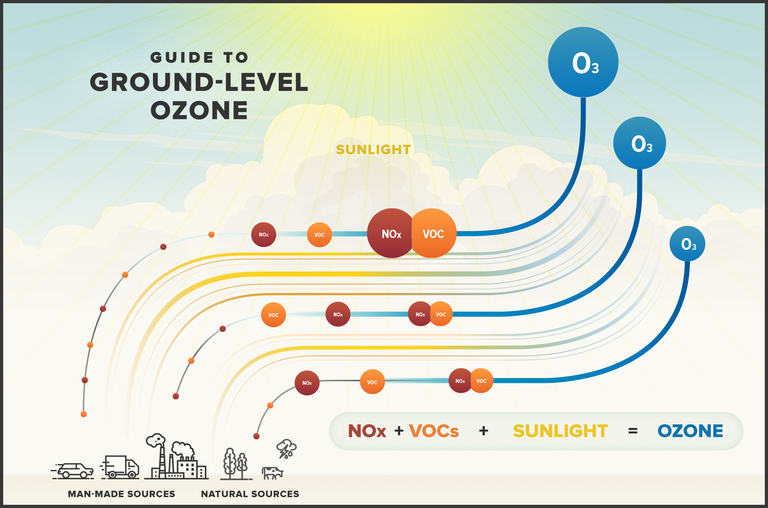Ozone Planning
Check the Air Quality Index Receive Air Quality Alerts
Together we can keep ground-level ozone levels down and air quality up.
Ground-Level Ozone (O3) is an invisible pollutant that threatens Albuquerque's air quality - but we have the power to reduce it. Vehicle owners can help reduce ground-level ozone by following these tips:
- Refuel your vehicle during the coolest times of day.
- Maintain proper tire pressure to boost your car's performance and our air quality.
- Turn off your engine instead of idling to save gas and reduces emissions.
- Bike, carpool, or use public transit to reduce emissions from vehicles.
The Air Quality Program's Ozone Reduction Initiative includes:
- Joining EPA’s voluntary Ozone Advance Program and hiring new staff to support this initiative
- Proposing California’s (Section 177) Advanced Clean Vehicle Regulations, in partnership with the state, which were adopted and codified into law
- Updating the vehicle emissions testing program
- Increasing public awareness on the dangers of ground-level ozone and actions to help reduce it
- Supporting the State’s efforts to reduce ozone precursor emissions from the oil and gas industry
Read the report that describes air quality modeling of factors contributing to high local ozone levels during June and July of 2017.
What is Ground-Level Ozone?
Ground-level ozone is created when Nitrogen Oxides (NOx) and Volatile Organic Compounds (VOCs), known as “ozone precursors,” react in heat and sunlight to form ozone. While some ozone precursors are naturally occurring (biogenic), most are man-made (anthropogenic). For example, emissions from power plants, factories, and vehicles, along with fumes from paints, solvents, and fuels contain NOx and VOCs. From May through September high levels of O3 are most likely to occur. When inhaled, ozone can cause a number of respiratory health effects. Ozone can also negatively affect plant life.

Health Effects
Ozone can cause coughing, throat irritation, and pain when taking a deep breath. It can also reduce lung function, inflame the linings of the lungs, and even trigger asthma attacks the day after ozone levels are high. Several groups of people are particularly sensitive to ozone, especially when they are active outdoors. This is because ozone levels are higher outdoors, and physical activity causes faster and deeper breathing, drawing more ozone into the body. When ozone levels are very high, everyone should be concerned about ozone exposure.
People who may experience increased health risks include:
- People with lung diseases, such as asthma, chronic bronchitis, and emphysema.
- Children are at higher risk from ozone exposure because:
- They often play outdoors in summer when ozone levels are higher.
- They are more likely to have asthma, which may be aggravated by ozone exposure.
- Their lungs are still developing.
- Older adults may be more affected by ozone exposure, possibly because they are more likely to have pre-existing lung disease.
- Active people of all ages who exercise or work vigorously outdoors have higher exposure to ozone than people who are less active.
When ozone levels are unhealthy, reduce your exposure by:
- Limiting the time you are active outdoors, or exercising indoors.
- Scheduling activity for early in the day when ozone levels are lowest. As the day progresses and the temperature rises, ozone levels also get higher.
- Avoiding high-traffic areas. Try not to walk, jog, or cycle along major roadways or places where cars tend to idle.
- Substituting a less intense activity. For example, go for a walk instead of a jog. For each person, intensity depends on physical fitness, but typically:
- Less intense activities include things like climbing stairs, playing tennis or baseball, simple garden or construction work, and light jogging, cycling, or hiking.
- More intense activities include playing basketball or soccer, chopping wood, heavy manual labor, and vigorous running, cycling, or hiking.
- Use ozone-reducing air filters indoors to control the ozone entering your home.
No matter how fit you are, cutting back on the level or duration of outdoor activity when ozone levels are unhealthy will help protect you from ozone’s harmful effects.
This guide provides ways to protect your health when ozone pollution reaches unhealthy levels. The chart tells you what types of health effects may occur at specific ozone concentrations and what you can do to avoid them. If you are a parent, keep in mind that your children are likely to be at higher risk, particularly if they are active outdoors
Find out when ozone levels are elevated in Albuquerque-Bernalillo County:
- Check the Air Quality Index to stay informed about ozone levels
- Sign up to receive air quality alerts via email. Email alerts include:
- Air Quality Index and Pollen Count (Monday - Friday)
- Health Alerts
- Wind and Dust Warnings
- Burn / No Burn Notifications
- Receive real-time emergency health alerts on your mobile phone.
- Text “ABQHEALTH” for alerts in English or “ABQSALUD” for alerts in Spanish to 226787 from your mobile phone. You will receive a welcome message and instructions to start or stop messages any time.
